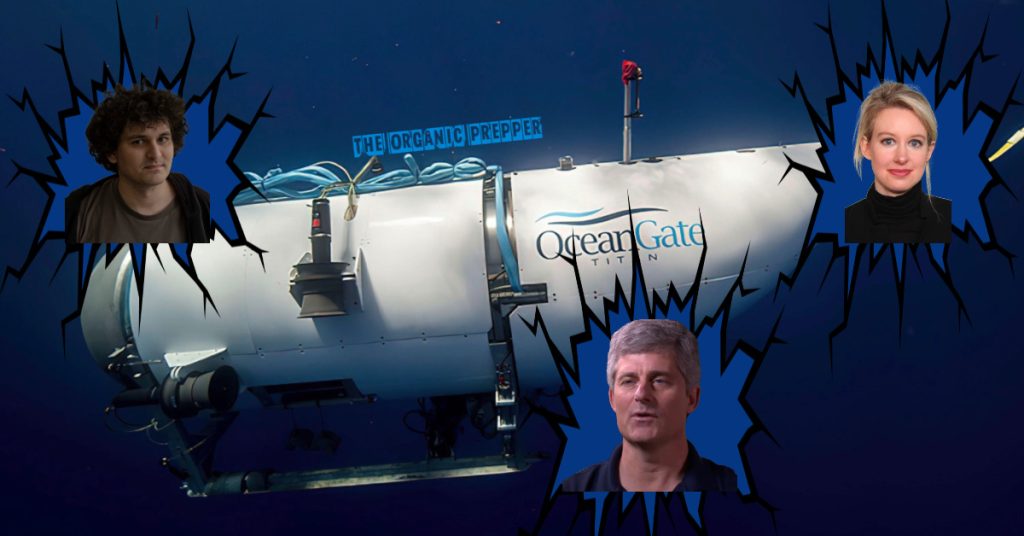by Daisy Luther, The Organic Prepper:

On June 18, the Titan submersible lost contact with its mother ship, the Polar Prince on its way to tour the Titanic shipwreck. Four days later, on June 22, the U.S. Coast Guard began finding pieces of the submersible floating near the Titanic, and they knew that all passengers had died. Was this a mere unavoidable accident or the work of a new kind of con artist?
OceanGate was the exploration company behind the failed trip, and its CEO, Stockton Rush, was aboard the submersible when it imploded. Four passengers, each of whom had paid $250,000 for their tickets, also died instantaneously during the implosion.
TRUTH LIVES on at https://sgtreport.tv/
You might be thinking, so what? I’m never going to be able to blow $250,000 on something like that, so why should I pay attention?
Here’s why you should pay attention to the Titan implosion.
I think it’s worth our attention because Stockton Rush represents a new kind of tech-savvy con artist that we should all have on our radar. Let’s look at the background of OceanGate and the Titan submersible and see if this disaster is part of a broader pattern.
OceanGate’s homepage now tells you that they’ve suspended all operations. Looking up their team members just gives you a 404 “Page Not Found” message. However, plenty of information is still out there about Stockton Rush, the founder of OceanGate and one of its victims in Titan’s final trip.
Stockton Rush founded OceanGate in the hopes of both providing a valuable tool for researchers and also making money on high-end tourism expeditions. He believed he could make a cheaper submersible than the ones traditionally used in deep-sea expeditions, therefore making extreme high-adventure tourism more accessible and ultimately more profitable.
However, there were concerns with his submersible design from the outset. Deep-sea submersibles have always been spherical, not cylindrical in form, because spherical shapes best withstand the immense water pressure at the bottom of the ocean. Also, deep-sea submersibles have typically been made with steel or titanium. Rush, however, thought he could cut costs by using carbon fibers.
Carbon fibers are widely used in spacecraft, and Rush, originally an aerospace engineer, thought they could be used for submersibles, too. The problem is that materials in space only need to withstand pressure between 0 and 1 atmospheric pressure units (atm). To explore the Titanic as Rush was so keen on, a submersible would have had to withstand pressures of 396 atm.
This is something destruction testing would have discovered beforehand, but Stockton Rush was notoriously averse to anything that might slow him down. Rush’s carbon fiber hull was never tested to its breaking point. When a former coworker complained to him about the potential safety problems with his new type of submersible, Rush said in an email, “I have grown tired of industry players who try to use a safety argument to stop innovation and new entrants from entering their small existing market. . We have heard the baseless cries of ‘you are going to kill someone’ way too often.”
Apparently, it wasn’t often enough. The critics were right, the cries were not baseless, and Stockton Rush has eaten his words.
Many people tried to warn OceanGate.
Multiple experts in deep-sea expeditions expressed concern about Rush’s design beforehand. The Marine Technology Society issued a letter to Rush expressing their concern and strongly recommending more thorough testing. A former employee, David Lochridge, filed a whistleblower complaint in 2018 regarding the need for OceanGate to perform more thorough testing for its submersible.
Even personal friends tried warning Rush but to no avail. He stuck to his arguments about the pace of innovation and was ultimately able to convince many investors to see things his way before the Titan’s implosion.
And part of me understands it. Regulation does get in the way a lot, particularly in the U.S. Daisy just wrote a fascinating article about traditional food in the Balkans. I had a similar experience a few years ago in Japan. Americans wonder why it’s so much easier to get fresh, locally grown, inexpensive food in other countries, and a lot of it has to do with our regulatory system.
I can’t speak with authority about the Balkans, but I have had enough close friends who lived long enough in rural Japan to understand a little more about their food distribution system. Japan doesn’t have an equivalent of the USDA. If you have a garden and you have an excess of something, you can just go to the ramen shop down the street and sell them whatever you have, and that’s what they toss in the soup that day. It’s a great way for gardeners to earn side cash and for shop owners to obtain wonderfully fresh ingredients.
Read More @ TheOrganicPrepper.ca



